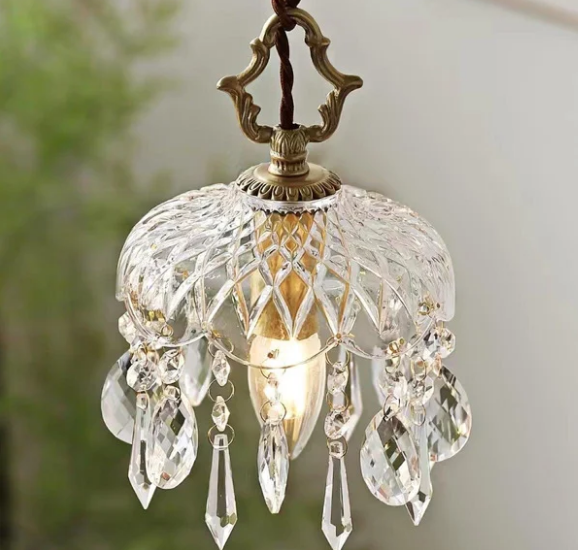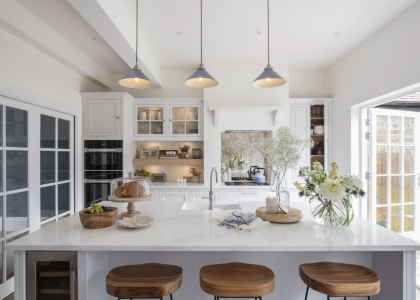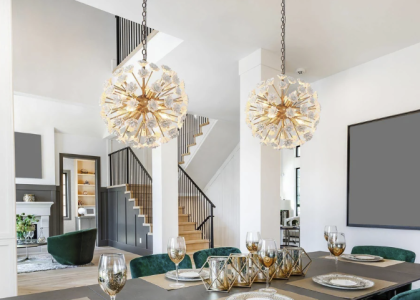Pendant lights are a type of lighting fixture that hangs from the ceiling, typically suspended by a cord, chain, or metal rod. They are a popular choice for kitchen lighting due to their versatility and ability to enhance the overall look of the space. Pendant lights can add both functionality and style to your kitchen, making them a great addition to any home.
One of the reasons why pendant lights are so popular in kitchens is their ability to provide focused task lighting. Whether you’re chopping vegetables, cooking a meal, or washing dishes, pendant lights can provide the right amount of light exactly where you need it. This makes them perfect for illuminating countertops and work areas, ensuring that you have ample light for all your kitchen tasks.
In addition to their functionality, pendant lights can also enhance the overall look of your kitchen. With their sleek and stylish designs, pendant lights can add a touch of elegance and sophistication to any space. They come in a wide variety of styles, sizes, and materials, allowing you to choose the perfect pendant lights that complement your kitchen décor. Whether you prefer a modern and minimalist look or a more traditional and ornate design, there is a pendant light out there that will suit your taste.
Benefits of pendant lights in the kitchen: Functionality and aesthetics
One of the main benefits of pendant lights in the kitchen is their ability to provide task lighting. Task lighting is essential in the kitchen as it helps you see clearly while preparing food, cooking, and doing other tasks. Pendant lights can be hung directly above countertops and work areas, providing focused light that eliminates shadows and allows you to see what you’re doing. This makes it easier and safer to chop vegetables, measure ingredients, and perform other kitchen tasks.
In addition to their functionality, pendant lights can also create a warm and inviting atmosphere in your kitchen. The soft glow of pendant lights can make the space feel cozy and welcoming, making it a place where family and friends naturally gather. Pendant lights can also be dimmed to create a more intimate ambiance, perfect for romantic dinners or late-night snacks. By choosing the right pendant lights and placing them strategically in your kitchen, you can create a space that is not only functional but also aesthetically pleasing.
Furthermore, pendant lights can add a touch of style and sophistication to your kitchen décor. With their wide range of designs, pendant lights can be used to make a statement or blend seamlessly with your existing kitchen style. Whether you prefer a sleek and modern look or a more traditional and rustic feel, there is a pendant light out there that will suit your taste. Pendant lights can serve as a focal point in your kitchen, drawing attention to a specific area or feature. They can also be used to tie together different design elements in your kitchen, creating a cohesive and harmonious look.
Choosing the right pendant lights for your kitchen: Size and style considerations
When choosing pendant lights for your kitchen, there are two main considerations: size and style. The size of the pendant lights you choose will depend on the size of your kitchen and the height of your ceiling. As a general rule of thumb, the diameter of the pendant light should be about one-third to two-thirds the width of the surface it is illuminating. For example, if you have a 6-foot island, you would want to choose pendant lights that are around 2-4 feet in diameter.
In terms of style, it’s important to choose pendant lights that complement your kitchen décor. If you have a modern and minimalist kitchen, you may want to opt for sleek and simple pendant lights with clean lines and minimal embellishments. On the other hand, if you have a more traditional or rustic kitchen, you may prefer pendant lights with ornate details and warm finishes. It’s also important to consider the overall color scheme of your kitchen and choose pendant lights that will blend seamlessly with the existing colors and materials.
Another option to consider is mixing and matching pendant lights for a unique and personalized look. You can choose different styles, sizes, and finishes of pendant lights and hang them at varying heights to create visual interest and depth. This can add a touch of creativity and personality to your kitchen, making it truly one-of-a-kind. Just make sure to maintain a cohesive look by choosing pendant lights that share a common element, such as color or material.
Types of pendant lights: From classic to contemporary designs
There are many different types of pendant lights available, ranging from classic to contemporary designs. Classic pendant lights are characterized by their timeless appeal and traditional features. They often feature ornate details, such as intricate metalwork or decorative glass shades. Classic pendant lights can add a touch of elegance and sophistication to any kitchen, making them a popular choice for those who prefer a more traditional aesthetic.
On the other hand, contemporary pendant lights are known for their sleek and modern designs. They often feature clean lines, minimalist shapes, and innovative materials. Contemporary pendant lights can add a sense of modernity and freshness to your kitchen, making them a great choice for those who prefer a more minimalist or industrial look.
In addition to classic and contemporary designs, there are also many other types of pendant lights available, such as industrial pendant lights, farmhouse pendant lights, and vintage pendant lights. Industrial pendant lights are characterized by their rugged and utilitarian look, often featuring metal shades and exposed bulbs. Farmhouse pendant lights have a rustic and charming appeal, often featuring distressed finishes and vintage-inspired details. Vintage pendant lights have a nostalgic and retro feel, often featuring antique finishes and intricate glass shades.
Pendant light placement: Creating the perfect lighting scheme in your kitchen
When it comes to pendant light hozo placement in your kitchen, there are a few factors to consider. First, you’ll want to determine the best placement for pendant lights based on the specific areas you want to illuminate. Pendant lights are commonly used above kitchen islands, dining tables, and countertops, as these are the areas where task lighting is most needed. By hanging pendant lights directly above these areas, you can ensure that you have ample light for all your kitchen tasks.
It’s also important to consider the height at which you hang your pendant lights. The height will depend on the height of your ceiling and the size of your pendant lights. As a general rule of thumb, pendant lights should be hung about 30-36 inches above a kitchen island or dining table. This allows for optimal task lighting while still maintaining a comfortable visual balance in the space. If you have higher ceilings or larger pendant lights, you may need to adjust the height accordingly.
In addition to providing task lighting, pendant lights can also be used to create a balanced and functional lighting scheme in your kitchen. By combining pendant lights with other types of lighting, such as recessed lights or under-cabinet lights, you can ensure that your kitchen is well-lit from all angles. This can help eliminate shadows and create a more even distribution of light throughout the space. It’s important to consider the overall layout and design of your kitchen when planning your lighting scheme, as well as any specific areas or features you want to highlight.
Pendant light materials: Glass, metal, and more

Pendant lights come in a wide variety of materials, each with its own unique look and feel. The material you choose for your pendant lights will depend on your personal style preferences and the overall look and feel of your kitchen décor.
One popular material for pendant lights is glass. Glass pendant lights can add a touch of elegance and sophistication to any space. They come in a variety of styles and finishes, from clear glass to frosted or colored glass. Clear glass pendant lights are a popular choice for those who want to showcase the beauty of the light bulb or add a touch of sparkle to their kitchen. Frosted or colored glass pendant lights can create a softer and more diffused light, perfect for creating a cozy and inviting atmosphere.
Another popular material for pendant lights is metal. Metal pendant lights can add a sleek and modern touch to your kitchen. They come in a variety of finishes, such as brushed nickel, chrome, brass, and copper. Each finish has its own unique look and feel, allowing you to choose the one that best complements your kitchen décor. Metal pendant lights can also be combined with other materials, such as glass or wood, to create a more eclectic and personalized look.
In addition to glass and metal, there are also pendant lights available in other materials, such as wood, fabric, and concrete. Wood pendant lights can add a natural and rustic touch to your kitchen, perfect for those who prefer a more organic look. Fabric pendant lights can add a soft and cozy feel to your kitchen, perfect for creating a warm and inviting atmosphere. Concrete pendant lights can add an industrial and edgy touch to your kitchen, perfect for those who prefer a more modern or minimalist look.
When choosing the material for your pendant lights, it’s important to consider not only the look and feel but also the durability and maintenance requirements. Some materials may be more prone to scratches or stains, while others may require special cleaning or care. It’s important to choose a material that suits your lifestyle and will stand up to the demands of your kitchen.
Pendant light colors: Matching your kitchen décor
The color of your pendant lights can have a big impact on the overall look and feel of your kitchen. By choosing the right color, you can create a cohesive and harmonious look that ties together all the elements in your kitchen décor.
When choosing the color of your pendant lights, it’s important to consider the existing colors in your kitchen. You can choose pendant lights that match the color of your cabinets, countertops, or backsplash to create a seamless and integrated look. For example, if you have white cabinets and a marble countertop, you may want to choose white or clear pendant lights to create a clean and cohesive look.
On the other hand, you can also use pendant light colors to create contrast and visual interest in your kitchen. If you have a neutral color scheme, such as white or gray, you can choose pendant lights in a bold and vibrant color to add a pop of color and personality to your space. For example, if you have a white kitchen, you may want to choose pendant lights in a bright red or blue color to create a focal point and make a statement.
Another option is to mix and match pendant light colors for a more eclectic and personalized look. You can choose pendant lights in different colors and hang them at varying heights to create visual interest and depth. This can add a touch of creativity and playfulness to your kitchen, making it truly unique. Just make sure to maintain a cohesive look by choosing pendant lights that share a common element, such as shape or material.
Pendant light installation: DIY or professional help?
The installation process for pendant lights can vary depending on the specific design and features of the lights. In some cases, pendant lights can be installed by homeowners as a DIY project. However, in other cases, it may be necessary to hire a professional electrician to ensure that the installation is done safely and correctly.
If you have experience with electrical work and feel comfortable working with wiring and electrical connections, you may be able to install pendant lights yourself. However, it’s important to keep in mind that working with electricity can be dangerous if not done properly. If you’re unsure about any aspect of the installation process or if you have any concerns about your ability to safely install the pendant lights, it’s best to hire a professional.
A qualified electrician will have the knowledge and expertise to safely install your pendant lights, ensuring that they are properly wired and securely mounted. They will also be able to advise you on the best placement and height for your pendant lights, as well as any additional considerations, such as load capacity or electrical codes. Hiring a professional can give you peace of mind knowing that your pendant lights are installed correctly and will provide safe and reliable lighting for years to come.
When looking for a qualified electrician to install your pendant lights, it’s important to do your research and choose someone who is licensed, insured, and experienced in residential electrical work. You can ask for recommendations from friends or family members, or you can search online for electricians in your area. Be sure to check their credentials and read reviews or testimonials from previous customers. It’s also a good idea to get multiple quotes and compare prices before making a final decision.
Maintenance and cleaning of pendant lights: Tips for long-lasting use
To ensure that your pendant lights continue to perform optimally and look their best, it’s important to clean and maintain them regularly. Here are some tips for maintaining and cleaning your pendant lights:
– Dust regularly: Dust can accumulate on the surface of your pendant lights, making them look dull and reducing their brightness. To prevent this, dust your pendant lights regularly using a soft cloth or duster. Be sure to turn off the power before cleaning and avoid spraying any cleaning solutions directly onto the light bulbs or electrical components.
– Clean glass shades: If your pendant lights have glass shades, they may become dirty or smudged over time. To clean glass shades, remove them from the pendant light fixture and wash them with warm soapy water. Rinse thoroughly and dry with a soft cloth before reattaching them to the fixture.
– Clean metal or other materials: If your pendant lights are made of metal or other materials, you can clean them using a soft cloth or sponge dampened with warm soapy water. Be sure to rinse thoroughly and dry with a soft cloth to prevent water spots or streaks.
– Replace light bulbs: Over time, the light bulbs in your pendant lights may burn out or become dim. It’s important to replace them promptly to ensure that your pendant lights continue to provide optimal lighting. Be sure to turn off the power before replacing the light bulbs and follow the manufacturer’s instructions for the specific type of bulb.
– Check electrical connections: Periodically check the electrical connections of your pendant lights to ensure that they are secure and in good condition. Loose or damaged connections can affect the performance and safety of your pendant lights. If you notice any issues, it’s best to contact a qualified electrician for inspection and repair.
– Troubleshoot common problems: If your pendant lights are not working properly, there are a few common issues that you can troubleshoot before calling a professional. Check the light switch to ensure that it is turned on and functioning correctly. Also, check the circuit breaker or fuse box to ensure that there are no tripped breakers or blown fuses. If you’re still experiencing issues, it’s best to contact a qualified electrician for further diagnosis and repair.
By following these maintenance and cleaning tips, you can ensure that your pendant lights continue to provide optimal performance and enhance the overall look of your space. First, regularly dust the surface of the pendant lights with a soft cloth or feather duster to remove any accumulated dirt or debris. Additionally, wipe down the lights with a damp cloth and mild soap solution to remove any stubborn stains or fingerprints. Avoid using harsh chemicals or abrasive materials that could damage the finish of the lights. It is also important to check the bulbs regularly and replace any that are burnt out or flickering. Finally, make sure to turn off the power supply before cleaning or performing any maintenance on the pendant lights to ensure safety.





